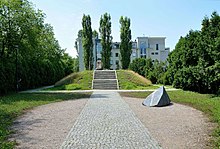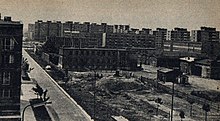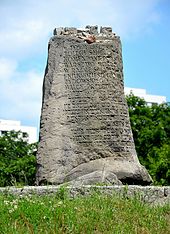Anielewicz Bunker
This article has multiple issues. Please help improve it or discuss these issues on the talk page. (Learn how and when to remove these template messages)
|
Bunkier Anielewicza | |
 View of Miła 18 Memorial | |
 | |
| Location | Warsaw, Poland |
|---|---|
| Designer | Hanna Szmalenberg and Marek Moderau (obelisk); Unknown (commemorative stone) |
| Material | Granite |
| Completion date | 1946, 2006 |
The Anielewicz Bunker (Polish: Bunkier Anielewicza), also known as the Anielewicz Mount (Polish: Kopiec Anielewicza) was the headquarters and hidden shelter of the Jewish Combat Organization (ŻOB), a Jewish resistance group in the Warsaw Ghetto in Poland during the Nazi German occupation of World War II.
Background
In October 1940, the governor of Nazi German-occupied Warsaw ordered city officials to begin construction of a ghetto for Jews in an area of Warsaw formerly used for quarantine during epidemics; it was completed on 15 November 1940. The initial population of Jews confined to the ghetto was 400,000. All windows, doors, and other exits to the rest of Warsaw were bricked up. From July to October 1942, over 310,300 Jews were removed from the ghetto, for transport to concentration camps or due to death.[1]
From 17 April 1943 to 18 May 1943, SS Brigadefuehrer Jürgen Stroop reported to SS-Obergruppenfuehrer and General of Police Krueger that 56,065 of the remaining Jews of the Warsaw ghetto were deported to death camps or exterminated by gunshot, explosion, fire, or asphyxiation.[1]
History

The bunker at Miła 18 was constructed by a group of Polish partisans and armed underground resistance fighters against the Germans.[2] They were joined there by the ŻOB fighters after their own hideout, at 29 Miła Street, had been discovered.[3]
From the Stroop Report, 7 May 1943:
The location of the dug-out used by the so-called select "Party Directorate" is now known. It is to be forced open tomorrow. The Jews testify that they emerge at night to get fresh air, since it is unbearable to stay permanently within the dug-outs owing to the long duration of the operation. On the average the raiding parties shoot 30 to 50 Jews each night. From these statements it was to be inferred that a considerable number of Jews are still underground in the Ghetto. Today we blew up a concrete building which we had not been able to destroy by fire. In this operation we learned that the blowing up of a building is a very lengthy process and takes an enormous amount of explosives. The best and only method for destroying the Jews therefore still remains the setting of fires.[4]
From the Stroop Report, 8 May 1943:
The whole former Ghetto was searched today by raiding parties for the remaining dug-outs and Jews. As reported some days a number of subhumans, bandits, and terrorists still remain in the dug-outs, where heat has become intolerable by reason of the fires. These creatures know only too well that their only choice is between remaining in hiding as long as possible or coming to the surface and trying to wound or kill off the men of the Waffen-SS, Police, and Wehrmacht who keep up the pressure against them. We continued today the operation against the dug-out of the so-called select 'Party Directorate' which we had discovered yesterday, as reported in my teletype message yesterday. We succeeded in forcing open the dug-out of the Party Directorate and in catching about 60 heavily armed bandits. We succeeded in catching and liquidating Deputy Leader of the Jewish Military Organization 'ZWZ' and his so-called Chief of Staff. There were about 200 Jews in this dug-out, of whom 60 were caught and 140 were destroyed, partly owing to the strong effect of smoke-candles, and partly owing to heavy explosive charges which were laid in several places. The Jews whom we caught had already reported that innumerable Jews had been killed by the effect of the smoke-candles. The fight of the first six days was hard, but now we are able to state that we are catching those Jews and Jewesses who were the ringleaders in those days. Every time a dug-out is forced open, the Jews in it offer resistance with the arms at their disposal, light machine guns, pistols, and hand grenades. Today we again caught quite a number of Jewesses who carried loaded pistols in their bloomers, with the safety catch released. Some depositions speak of 3 to 4,000 Jews who still remain in underground holes, sewers, and dug-outs. The undersigned is resolved not to terminate the large-scale operation until the last Jew has been destroyed.[4]
On 8 May 1943, three weeks after the start of the Warsaw Ghetto Uprising, when the bunker was found by the Nazis, there were around 300 people inside. The armed resistance fighters surrendered, but the ŻOB command, including Mordechaj Anielewicz, the leader of the Warsaw Ghetto uprising, stood firm. The Nazis threw tear gas into the shelter to force the occupants out. Anielewicz, his girlfriend Mira Fuchrer and many of his staff committed mass suicide by ingesting poison rather than surrender, though a group of 30 or 35 fighters eluded the SS and escaped from the Ghetto through a sewer in Prosta Street to the "Aryan side" of Warsaw on May 10, 1943.[5][6]
Remembrance

In July 1945, survivors of the Jewish Underground (among them Simcha Rotem) visited the ruins above the Command bunker.[7][8] The bodies of Jewish fighters were not exhumed after 1945 and the place gained the status of war memorial.
In 1946, the monument known as Anielewicz Mound, made of the rubble of Miła houses, was erected. A commemorative stone inscribed in Polish and Yiddish was placed on top of the mound.

In 2006, a new obelisk designed by Hanna Szmalenberg and Marek Moderau was added to the memorial. The inscription in Polish, English and Yiddish reads:
Grave of the fighters of the Warsaw Ghetto Uprising built from the rubble of Miła Street, one of the liveliest streets of pre-war Jewish Warsaw. These ruins of the bunker at 18 Miła Street are the place of rest of the commanders and fighters of the Jewish Combat Organization, as well as some civilians. Among them lies Mordechaj Anielewicz, the Commander in Chief. On May 8, 1943, surrounded by the Nazis after three weeks of struggle, many perished or took their own lives, refusing to perish at the hands of their enemies. There were several hundred bunkers built in the Ghetto. Found and destroyed by the Nazis, they became graves. They could not save those who sought refuge inside them, yet they remain everlasting symbols of the Warsaw Jews’ will to live. The bunker at Miła Street was the largest in the ghetto. It is the place of rest of over one hundred fighters, only some of whom are known by name. Here they rest, buried as they fell, to remind us that the whole earth is their grave.[citation needed]
The names of 51 Jewish fighters whose identities have been established by historians are engraved on the front of the obelisk. Although it is often claimed that Miła 18 was the last shelter in the Ghetto to fall, this was not the case according to Jürgen Stroop, who reported that his men took 30 "bunkers" on 12 May 1943 alone. It should be also noted that the current building numbering of Mila Street does not correspond to the wartime numbering: the memorial is now located at the intersection of Miła and Dubois Streets while the current Miła 18 is an apartment block around 700 metres to the west.
Jewish fighters who died at Miła 18

- Chaim Akerman
- Małka Alterman
- Mordechaj Anielewicz
- Nate Bartmeser
- Heniek Bartowicz
- Franka Berman
- Tosia Berman
- Icchak Blaustein
- Melach Błones
- Berl Braude
- Icchak Chadasz
- Nesia Cukier
- Icchak Dembiński
- Józef Fass
- Efraim Fondamiński
- Towa Frenkel
- Emus Frojnd
- Mira Fuchrer
- Wolf Gold
- Miriam Hajnsdorf
- Aron Halzband
- Rut Hejman
- Mira Izbicka
- Salke Kamień
- Ziuta Klejnman
- Jaffa Lewender
- Lolek (first name only)
- Sewek Nulman
- Abraham Orwacz
- Rywka Pasamonik
- Majloch Perelman
- Aron Rajzband
- Lutek Rotblat
- Miriam Rotblat
- Jardena Rozenberg
- Salka (first name only)
- Jerzy Sarnak
- Szmuel Sobol
- Basia Sylman
- Szyja Szpancer
- Moniek Sztengel
- Szulamit Szuszkowska
- Mojsze Waksfeld
- Olek Wartowicz
- Icchak Wichter
- Arie Wilner
- Zeew Wortman
- Hirsz Wroński
- Rachelka Zylberberg
- Moszek Zylbertszajn
- Sara Żagiel
References
- ^ a b "The Stroop Report: The Warsaw Ghetto is No More". fcit.usf.edu. University of South Florida: Florida Center for Instructional Technology, College of Education. 2005. Retrieved 22 April 2024.
- ^ "Stroop's Final Report on the Battles in the Warsaw Ghetto Revolt (May 1943)". www.jewishvirtuallibrary.org. Nuremberg Documents, PS-1061. 16 May 1943. Retrieved 22 April 2024.
Bandit was the word used by the Germans for partisans and armed underground fighters
- ^ J.Leociak, Spojrzenia na warszawskie getto. Ulica Miła, Dom Spotkań z Historią, Warszawa 2011, p. 26.
- ^ a b "The Stroop Report". fcit.usf.edu. Florida Center for Instructional Technology. 2005. Retrieved 15 July 2021.
- ^ C.Lubetkin, Zagłada i powstanie, Książka i Wiedza, Warszawa 1999.
- ^ "The Stroop Report (May 1943)". www.jewishvirtuallibrary.org. Retrieved 22 April 2024.
- ^ "Mila 18 Bunker site photograph". Sztetl org.
- ^ Sztetl org Mila 18 Bunker site photograph
- Articles lacking reliable references from April 2024
- All articles lacking reliable references
- Wikipedia articles with style issues from April 2024
- All articles with style issues
- Articles with multiple maintenance issues
- Infobox mapframe without OSM relation ID on Wikidata
- All articles with unsourced statements
- Articles with unsourced statements from July 2021
- Commons category link is on Wikidata
- Coordinates on Wikidata
- Warsaw Ghetto Uprising
- Buildings and structures in Warsaw
- Warsaw in World War II
- Jewish resistance during the Holocaust
- Jewish Polish history
- Mass suicides
- Monuments and memorials in Warsaw
- Tourist attractions in Warsaw
- Pages using the Kartographer extension